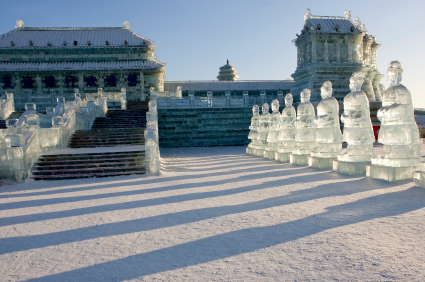1898-1914
1898 -Mar.27, China grants Russia a 25-year lease on the Liaotung Peninsula and a concession to build a South Manchurian Railroad . This treaty provides the impetus for Jews to enter China leaving behind pogroms and persecution in favor of a life free of the Czarist restrictions placed on the Jews in Russia
In the 1900 first recorded Minyan takes place on Magazinskaya Ulitsa at the home of I.L Bach. Prayers are held until 1902 at the residence of the Berkovich Family. In 1902-1903, to cater for the needs of the religious community, the Spiritual committee is formed. The committee consists of Mr. Meerovich (the Gabay), E.I. Dobisov (Treasurer), K.L. Furvich, M.L. Samsonovich (Committee Member). Mr. Naer, a Shochet, is engaged. A small building is acquired on Artillery St. 6 and the first synagogue is established.
Rabbi Levin is invited to be the first full-time Rabbi in 1903. Under his supervision all religious functions are put in place and a school in the synagogue's yard is established. The Jewish presence is rapidly expanding - to the extent that additional space is needed for the high holidays.
1904-1905 marks the years of the Russo-Japanese. Because of its proximity to the area of the war Harbin becomes a logistic and administrative centre. Thousands of Jewish soldiers are stationed there and the community under the guidance of Rabbi Levin organizes help for the wounded Jewish servicemen. The community provides financial and spiritual support with the help of a ladies committee under the guidance of Rabbi Levin's wife. Ladies of this committee visit wounded servicemen in hospitals, sew their clothes and help with personal matters. The community takes upon itself to provide burials in accordance with Jewish tradition and also provides thousands of meals for Passover (1904-1905). Matzo is partly provided by the community kitchens and partly imported from Russia. 1905 sees the end of the war and the repatriation of the army and the hospitals. The community reverts to its peacetime existence.
Several crucial decisions are taken after the war. In 1907 a full time Jewish School is established and construction of the main synagogue begins, ground for which was laid in 1906.
In 1908 a library is established (libraries played an important role in community life as a source of knowledge, entertainment and study. This is repeated in Tianjin (Tientsin) and Shanghai in later years). The library takes shape; old books are renovated and new books acquired. The subscription base expands to 300. By 1930 the daily readership approaches 80-100 readers and an average of 140 books are lent daily. The library caters to 23,000 readers a year and lends 34,000 books.
1909 is a milestone in the life of the Jews of Harbin. The construction of the main synagogue is accepted by the committee.
In June of 1912 the Committee for Jews for Resettling in Palestine (The Palestinian Committee) was established to provide an umbrella for all Zionist and cultural activities. Up to that time the Zionist organizations functioned in a quasi legal manner. That year sees the establishment of a reading room holding publications in Russian, Hebrew and Yiddish.
Zionist activity is accelerated with the arrival of Dr. A. Kaufmann (the President of the Jewish Community from 1919-1931 and from 1933-1945) Already known for his Zionist activity from his days in the University in Berne, Switzerland Dr. Kaufman organizes lectures and meetings. An important event is the exhibition of works by Bezalel of Jerusalem.

